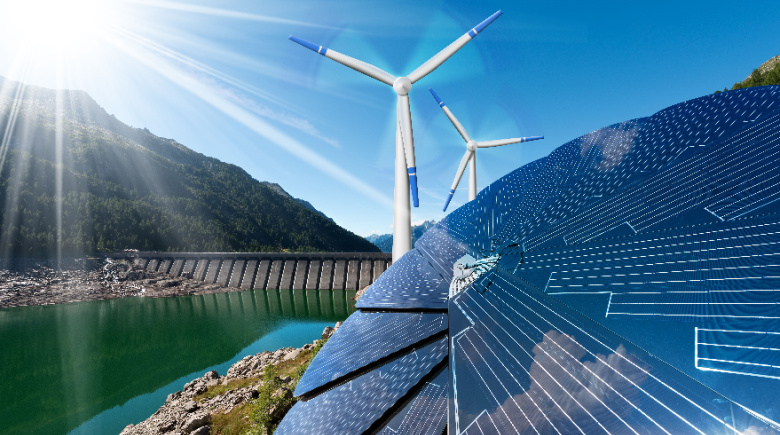Whether we like it or not, we’re facing a lot of problems when it comes to the environment and mankind’s impact on the earth. Renewable energy could potentially be the saving grace we need to diminish the harm we’re doing to the planet and to ensure that generations to come will be able to live and thrive safely.
So what exactly is renewable energy? Renewable energy is energy that isn’t finite. You might not realize it, but the gas we put in our automobiles is classified as fossil fuel, and there’s only so much fossil fuel on the planet. This means that once we’ve used up all of the oil on earth, we’re done with it forever.
Thankfully, renewable energy sources aren’t finite, which means that if we can switch to renewable energies as our primary energy sources, we won’t have to worry about running out of them in the future. As an added bonus, they have fewer harmful emissions and are better for the earth than their finite counterparts.
To help you become better educated on the matter so that you can do your part to reduce harm to the earth, here are the five types of renewable energy.
Solar Energy
Perhaps the most common form of renewable energy, solar energy has become more and more popular over the past decade. Aside from the fact that it’s monumentally better for the earth than its alternatives, it has the added bonus of helping homeowners to cut down on their electric bills. If you see more solar panels popping up on rooftops in your neighborhood, you can rest assured that your neighbors are saving a fortune.
Solar energy works by utilizing something called photovoltaic cells, which are beamed down in sunlight and are converted to electric currents through solar panel technology. Although currently most utilized as an alternative to traditional energy sources in homes or businesses, the technology is fast being developed to find ways to power vehicles through solar power.
One of the biggest benefits of solar power is the fact that the sun is everywhere. Whereas certain areas might not be windy enough for wind turbines or might not have the water necessary for hydropower, almost everywhere on earth experiences sunlight. Hence, this technology is invaluable in the developing world and has already been used to assist nations that were struggling with reliable energy sources.
Wind Energy
Wind energy works by converting the kinetic energy of the wind into electric power via wind turbines. While not all areas are as suitable for wind energy turbines as they are for solar panels, for areas that do experience high winds, this can be a fantastic source of renewable energy.
As with solar panels, one of the benefits of wind energy is that it can be used to power very small dwellings or very large ones. Large “wind farms” with acres of turbines can be used to power entire towns, while some renewable dwellings can be powered by a single turbine. While these turbines aren’t as easy to install as solar panels, they’re relatively low maintenance and can last for decades, making them a fantastic renewable energy option.
Hydropower
Hydropower, a longstanding and dependable source of renewable energy, utilizes the energy of flowing water to generate electricity through dams. As a technology, hydropower actually predates solar energy. Chances are you remember visiting a dam long before you remember seeing solar panels on your neighbors’ homes.
While hydropower isn’t an option for powering a single dwelling, it can be a beautifully renewable source for entire towns. However, this is only an option for communities that have running bodies of water, such as rivers or some streams. While hydropower isn’t a cure-all solution for every area of the world, it’s a fantastic choice for communities that have the natural resources to accommodate it.
Geothermal Energy
Geothermal energy uses the earth’s internal heat to produce electricity. Geothermal power plants work by drilling deep into the earth to tap for steam or hot water, which is converted into usable energy. One of the major benefits of geothermal energy is that it has a very low environmental impact. However, similar to hydropower, some areas lend themselves better to geothermal energy than others. It’s not quite as simple as just drilling into the ground anywhere on earth; rather, you need to find volcanic areas or naturally occurring geothermal hotspots.
Biomass Energy
If you’ve heard of cars that are engineered to run on leftover cooking oil, then you’ve heard of biomass energy. Biomass energy essentially just uses any renewable, naturally occurring matter as a source to create energy. Other types of biomass energy include wood, plant residue and organic waste. These materials are converted into energy via combustion, making them very similar to fossil fuels. However, unlike fossil fuels, these energy sources are completely renewable and without the toxic emissions that harm our planet and contribute to global warming.
Conclusion
From the powerful sun to the blowing wind, renewable energy sources have the potential to power our lives without destroying our planet. When it comes to finding ways to generate power without harming the earth, there’s no more time to waste when it comes to going green and putting an end to fossil fuels and global warming.
Moving away from nonrenewable energy sources doesn’t have to be a costly burden, however. As the science improves and renewable energy technology becomes more advances, these renewable energies are becoming more accessible to people across the globe with every passing year.
In the meantime, if you can’t make the switch to renewable energy immediately, try finding ways to reduce your energy expenditure, such as walking instead of driving or switching to energy-efficient appliances. When it comes to helping our earth, every little bit counts.
Whether we like it or not, we’re facing a lot of problems when it comes to the environment and mankind’s impact on the earth. Renewable energy could potentially be the saving grace we need to diminish the harm we’re doing to the planet and to ensure that generations to come will be able to live and thrive safely.
So what exactly is renewable energy? Renewable energy is energy that isn’t finite. You might not realize it, but the gas we put in our automobiles is classified as fossil fuel, and there’s only so much fossil fuel on the planet. This means that once we’ve used up all of the oil on earth, we’re done with it forever.
Thankfully, renewable energy sources aren’t finite, which means that if we can switch to renewable energies as our primary energy sources, we won’t have to worry about running out of them in the future. As an added bonus, they have fewer harmful emissions and are better for the earth than their finite counterparts.
To help you become better educated on the matter so that you can do your part to reduce harm to the earth, here are the five types of renewable energy.
Solar Energy
Perhaps the most common form of renewable energy, solar energy has become more and more popular over the past decade. Aside from the fact that it’s monumentally better for the earth than its alternatives, it has the added bonus of helping homeowners to cut down on their electric bills. If you see more solar panels popping up on rooftops in your neighborhood, you can rest assured that your neighbors are saving a fortune.
Solar energy works by utilizing something called photovoltaic cells, which are beamed down in sunlight and are converted to electric currents through solar panel technology. Although currently most utilized as an alternative to traditional energy sources in homes or businesses, the technology is fast being developed to find ways to power vehicles through solar power.
One of the biggest benefits of solar power is the fact that the sun is everywhere. Whereas certain areas might not be windy enough for wind turbines or might not have the water necessary for hydropower, almost everywhere on earth experiences sunlight. Hence, this technology is invaluable in the developing world and has already been used to assist nations that were struggling with reliable energy sources.
Wind Energy
Wind energy works by converting the kinetic energy of the wind into electric power via wind turbines. While not all areas are as suitable for wind energy turbines as they are for solar panels, for areas that do experience high winds, this can be a fantastic source of renewable energy.
As with solar panels, one of the benefits of wind energy is that it can be used to power very small dwellings or very large ones. Large “wind farms” with acres of turbines can be used to power entire towns, while some renewable dwellings can be powered by a single turbine. While these turbines aren’t as easy to install as solar panels, they’re relatively low maintenance and can last for decades, making them a fantastic renewable energy option.
Hydropower
Hydropower, a longstanding and dependable source of renewable energy, utilizes the energy of flowing water to generate electricity through dams. As a technology, hydropower actually predates solar energy. Chances are you remember visiting a dam long before you remember seeing solar panels on your neighbors’ homes.
While hydropower isn’t an option for powering a single dwelling, it can be a beautifully renewable source for entire towns. However, this is only an option for communities that have running bodies of water, such as rivers or some streams. While hydropower isn’t a cure-all solution for every area of the world, it’s a fantastic choice for communities that have the natural resources to accommodate it.
Geothermal Energy
Geothermal energy uses the earth’s internal heat to produce electricity. Geothermal power plants work by drilling deep into the earth to tap for steam or hot water, which is converted into usable energy. One of the major benefits of geothermal energy is that it has a very low environmental impact. However, similar to hydropower, some areas lend themselves better to geothermal energy than others. It’s not quite as simple as just drilling into the ground anywhere on earth; rather, you need to find volcanic areas or naturally occurring geothermal hotspots.
Biomass Energy
If you’ve heard of cars that are engineered to run on leftover cooking oil, then you’ve heard of biomass energy. Biomass energy essentially just uses any renewable, naturally occurring matter as a source to create energy. Other types of biomass energy include wood, plant residue and organic waste. These materials are converted into energy via combustion, making them very similar to fossil fuels. However, unlike fossil fuels, these energy sources are completely renewable and without the toxic emissions that harm our planet and contribute to global warming.
Conclusion
From the powerful sun to the blowing wind, renewable energy sources have the potential to power our lives without destroying our planet. When it comes to finding ways to generate power without harming the earth, there’s no more time to waste when it comes to going green and putting an end to fossil fuels and global warming.
Moving away from nonrenewable energy sources doesn’t have to be a costly burden, however. As the science improves and renewable energy technology becomes more advances, these renewable energies are becoming more accessible to people across the globe with every passing year.
In the meantime, if you can’t make the switch to renewable energy immediately, try finding ways to reduce your energy expenditure, such as walking instead of driving or switching to energy-efficient appliances. When it comes to helping our earth, every little bit counts.



